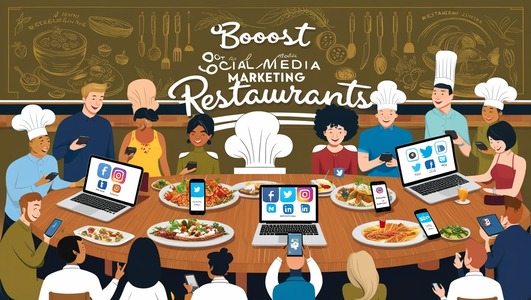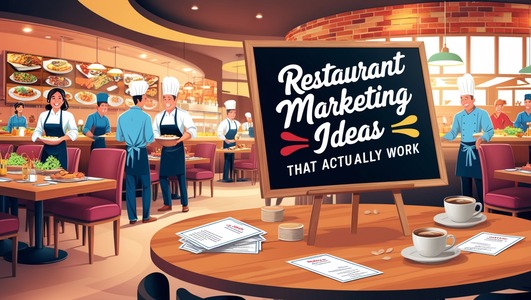Affordable Marketing for Restaurants: Low-Cost, High-Impact Ideas
In today’s crowded restaurant market, good food and service aren’t enough. You need a strong marketing plan to get noticed, keep customers coming back, and grow your business.
In this article, we’ll explore the best restaurant marketing strategies, focusing on digital techniques, social media, loyalty, and brand positioning. All of this is presented in clear language, with practical examples and useful tips to apply today.
What is restaurant marketing?
Restaurant marketing means using different ideas and actions to get more customers, keep them coming back, and help the restaurant make more money. It includes things like social media, loyalty programs, local SEO, content, and ads.
1. Create a strong brand identity
Your restaurant needs a recognizable, consistent, and attractive brand. This includes:
• Unique name and logo
• Consistent color palette and typography across all channels
• Brand voice (formal, fun, approachable, elegant, etc.)
• Restaurant story (origin, mission, values)

2. Digital Marketing for Restaurants
Digital marketing is essential. Here are some key tactics:
a. Create an optimized website
Your website is your online business. It should include:
• Updated menu
• Contact and location information
• Hours
• Online reservations
• Customer reviews
• Responsive design (mobile-friendly)
b. Work on local SEO
Local SEO helps people in your area find your restaurant on Google. Make sure to:
• Create and optimize your Google Business Profile
• Include keywords with geolocation
• Request positive customer reviews
• Be listed on local directories and food apps (TripAdvisor, Yelp, Uber Eats, etc.)
c. Social Media Marketing for Restaurants
Social media is essential for restaurant marketing. It allows you to showcase your food, atmosphere, and brand values. The best platforms for a restaurant are:
• Instagram: ideal for showing photos of dishes, behind-the-scenes videos, and promotions.
• Facebook: useful for events, schedules, general information, and community.
• TikTok: perfect for creative content, video recipes, challenges, and trends.
• WhatsApp Business: for orders, reservations, and direct contact.
Social Media Tips:
• Post quality content regularly
• Use relevant hashtags
• Share everyday stories
• Interact with your followers
• Collaborate with local food influencers
3. Customer Loyalty Strategies
It’s not just about attracting new customers, but also about retaining them and encouraging them to come back. Some loyalty strategies include:
a. Rewards Programs
Offer points for every purchase, special discounts, free drinks for every 10th visit, among others.
b. Email Marketing for Restaurants
Send emails with:
• Menu updates
• Special events
• Discount coupons
• Birthday promotions
Segment your email lists to offer more personalized content and increase effectiveness.
c. Satisfaction Surveys
Ask for feedback and use that information to improve. Making your customers feel heard is a powerful way to build loyalty.

4. Restaurant Advertising: Pay to Grow
Paid digital advertising allows you to reach a wider audience quickly. Some options:
a. Google Ads
You can appear at the top of the results when someone searches for “Italian restaurant in [your city].” Ideal for attracting active customers.
b. Social Media Ads
Platforms like Facebook and Instagram Ads allow you to target by age, location, interests, and behaviors. Create visually compelling ads with promotions or videos of dishes.
c. Local Offline Advertising
Don’t forget traditional methods such as:
• Flyers
• Posters in nearby areas
• Local radio advertising
• Partnerships with neighboring businesses
5. Promotions and Events to Attract Customers
Themed events and special promotions are a great way to attract new visitors.
Promotion Ideas:
• 2-for-1 drinks on Tuesdays
• Set menu with free drinks
• Student discount
• Happy hour
Recommended Events:
• Karaoke night or live music
• Themed dinners (Mexican, Italian, Asian)
• Cooking classes
• Wine tastings
• These events generate social media content and positive word of mouth.
6. Collaborations and Influencer Marketing for Restaurants
Working with local food influencers or foodies can quickly increase your visibility. Choose people with a good reputation and a real audience. You can offer:
• Free food in exchange for posts
• Exclusive events for influencers
• Joint promotions
• You can also collaborate with suppliers, chefs, artists, or local brands to create unique experiences.

7. Create valuable content
Content marketing isn’t just for corporate blogs. Restaurants can also create value by sharing useful and entertaining content. Examples:
• Simple video recipes
• Cooking tips
• Trending facts about ingredients
• Stories behind your dishes
8. Take advantage of delivery platforms
Apps like Uber Eats, Rappi, Glovo, or Just Eat are powerful channels for increasing sales. Some tips:
• Take care of your photos and descriptions
• Offer attractive combos
• Ensure optimal delivery times
• Ask your customers to leave reviews
Combine this channel with WhatsApp marketing or your ordering system to diversify your income.
9. Measure your results and adjust your strategy
What you don’t measure, you can’t improve. Use tools like:
• Google Analytics: to see who visits your website
• Social media statistics: to find out what type of content works best
• Email marketing platforms: to understand open and click rates
• Satisfaction surveys
Analyze which strategies generate the most customers and which ones you should improve or discard.
10. Restaurant Marketing Success Stories
Let’s look at some real-life examples of restaurants that have successfully used marketing:
a. Tasty Urban Food
A modern street food restaurant that embraced Instagram. They created a unique visual style with creative reels, collaborations with local influencers, and flash promotions. In less than a year, they doubled their daily reservations.
b. La Cava de Vinos
A restaurant specializing in wine pairings, which launched a YouTube channel featuring sommelier interviews, recipes, and virtual tastings. Today, they have an active community, and their events fill up in just a few hours.
c. El Patio Mexicano
During the pandemic, they offered virtual traditional cooking classes. They turned their crisis into an opportunity to build loyalty and today have a loyal community that attends their events and recommends the venue.
Conclusion: Marketing for Restaurants
Restaurant marketing is not optional—it’s something every restaurant needs. With so much competition, having a clear plan, using online tools, building customer relationships, and trying new ideas can help you get more customers, grow your reputation, and make more money.
Credit by Adam Guild – Owner
What is local SEO in restaurant marketing?
Local SEO makes your restaurant easier to find on search engines when people search for food or places to eat nearby.
How can I increase foot traffic to my restaurant?
Use promotions, local advertising, Google Maps listings, and social media ads to bring more people to your restaurant.
How often should restaurants post on social media?
Posting 3–5 times a week is ideal to stay active and engage your audience without overwhelming them.
What is influencer marketing for restaurants?
It’s when local influencers promote your restaurant on social media, helping you reach a bigger audience.
Should restaurants have a blog?
Yes, a blog improves SEO, shares your story, promotes events, and keeps your website active.
Is paid advertising effective for restaurants?
Yes, ads on Facebook, Instagram, and Google can bring quick results by targeting your ideal customers.
How can I market a new restaurant?
Use grand opening events, social media buzz, local press releases, and influencer visits to create excitement.
Can restaurant marketing improve customer loyalty?
Yes, loyalty programs, personalized emails, and excellent service help keep customers coming back.
How much should I spend on restaurant marketing?
A good rule is to spend 3–6% of your monthly revenue on marketing, depending on your goals and size.




